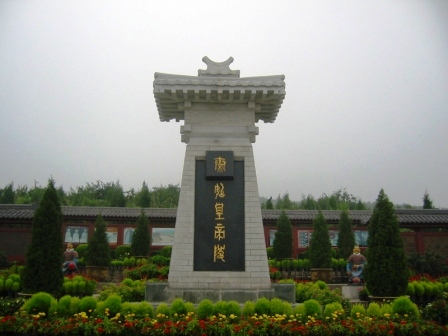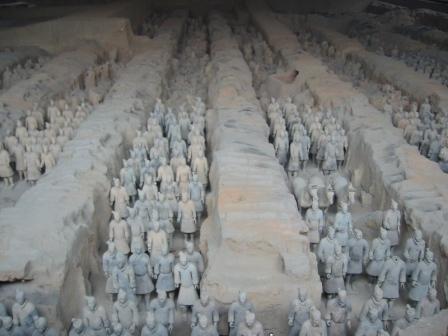 First Emperor’s mausoleum First Emperor’s mausoleum
秦始皇陵
 The First Emperor of China’s terracotta warriors, 秦始皇兵马俑, are world famous and are a must go when visiting Xian. China. However, not many visitors go to the nearby lesser known but even more important site, the tomb of the first emperor, Qin Shi Huang, 秦始皇. The First Emperor of China’s terracotta warriors, 秦始皇兵马俑, are world famous and are a must go when visiting Xian. China. However, not many visitors go to the nearby lesser known but even more important site, the tomb of the first emperor, Qin Shi Huang, 秦始皇.
While the First Emperor of China spent years seeking the elixir of immortality leading to legends about the Japanese race, the pragmatic side of him also proceeded with the construction of his mausoleum. Being the most important part of an expansive mausoleum that includes the famous terracotta warriors, the tomb complex today is a nondescript hill.
The tomb complex
A recently constructed stele in the middle of a landscaped garden proclaims it as the burial site of Qin Shi Huang, the First Emperor of China.
The unassuming hill hardly hints to the vast amount of treasure buried within. The famous Han historian Sima Qian offered us a glimpse of its interior in his “Records of the Historian” compiled during the Han dynasty about a century after the fall of Qin dynasty.
The underground palace
The First Emperor of China was buried in a copper coffin placed in the central chamber. In another chamber, a miniature model of the Qin Empire was constructed with precious stones showing the terrain and famous mountains. The rivers, lakes and seas were filled with mercury propelled by mechanisms simulating the tides and river flows.
Maybe surprising to some, whale fats were used as fuel to illuminate the tomb. These whale fats were obtained from whales slaughtered as Xu Fu went in search of the elixir. Above, precious stones representing stars and heavenly bodies decorate the ceiling. Other chambers held rare treasures collected from all over the vast empire.
To defend against tomb robbers, the pathways inside the tomb are lined with traps including poison tipped arrows waiting to be activated.
It was also recorded that the tomb has two heavy stone doors. The first door sealed the tomb while the second stone door cruelly traps the large numbers of artisans and workers slowly killing them so that secrets of the tomb dies with them.
Secrets waiting to be uncovered
The soil from the tomb has much higher mercury content supporting Sima Qian’s records. The First Emperor’s tomb has yet to be excavated and may not happen soon although it was believed that some of its treasures emerged during the Song dynasty.
The main obstacle being the lack of technology to protect the relics once they leave the two thousand year old cocoon. When the terracotta warriors first emerged, they were colored but these quickly disintegrated and turned grey.
More research and advances in technology is required before the First Emperor’s tomb is opened. And when that happens, it will dramatically change our understanding of his life and life under his rule more than 2000 years ago.
Related Article:
|

 First Emperor’s mausoleum
First Emperor’s mausoleum


